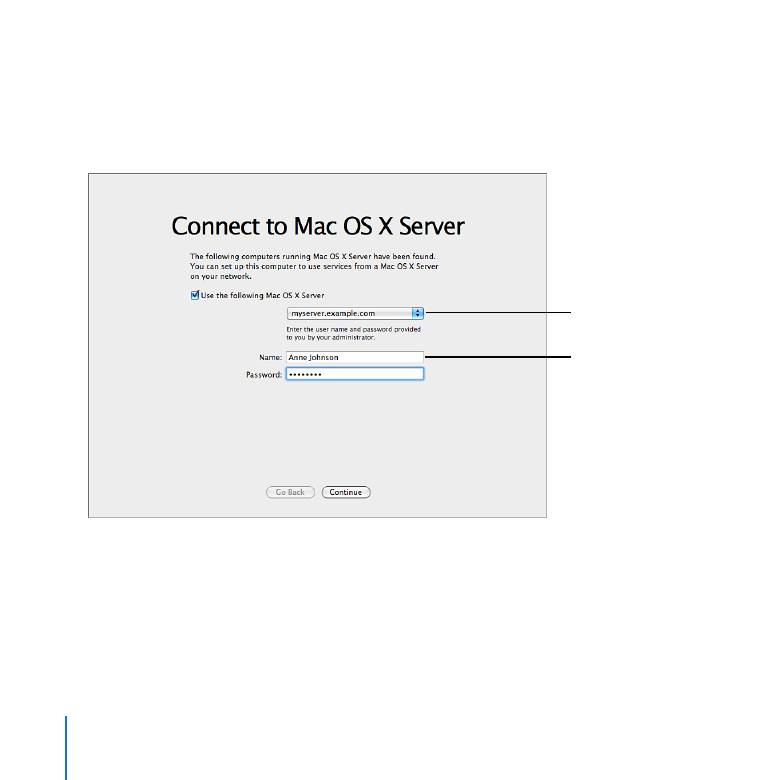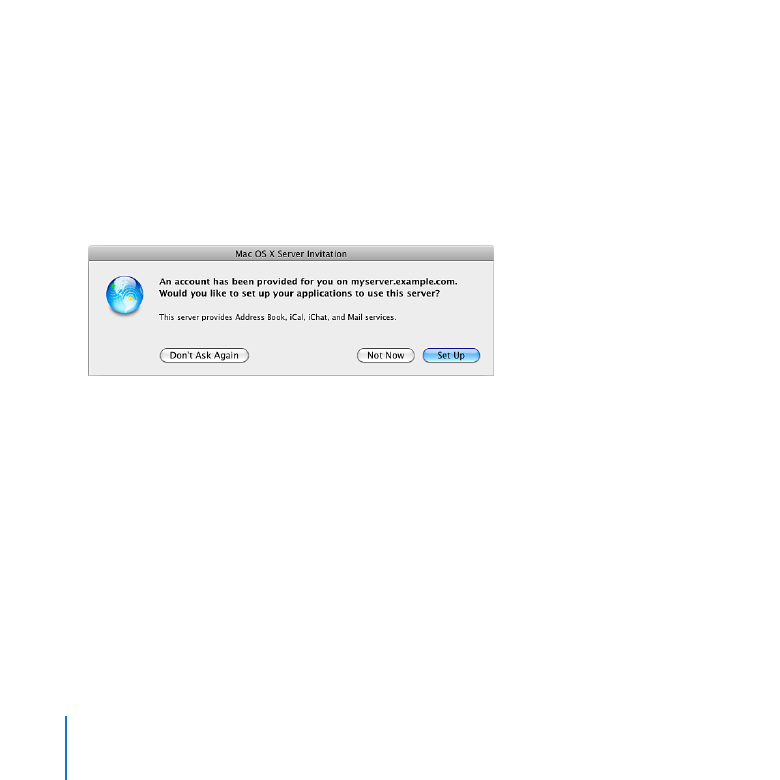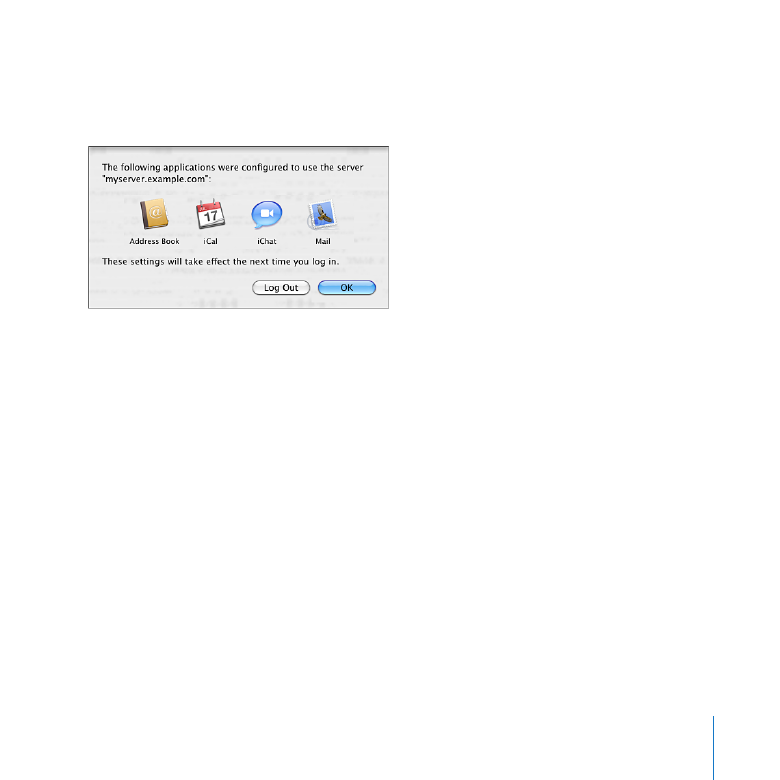
Setting Up Users’ Macs Automatically
Users who have Mac OS X v10.6 Snow Leopard can automatically set up their Macs
to get services from your server. The procedure is different for three types of users,
as explained in the following table.

106
Chapter 7
Managing Users’ Computers
Automatic setup for
Begins when
For information, see
Users who have a new Mac or
Snow Leopard newly installed
and have an account on your
server
Users complete the “Connect
to Mac OS X Server” pane
during Mac OS X setup
“Setting Up New Macs” on
page 108
Current users of Snow Leopard
who have accounts on your
server
Users connect their computers
to your server’s network
“Setting Up Macs That Join
Your Network” on page 110
Current users of Snow Leopard
whose accounts you import
using Server Preferences
Users click the button in the
invitation email they receive
“Setting Up Newly Imported
Users’ Macs” on page 111
User Account Changes
After a user finishes one of the automatic setup procedures, the user’s local account
(on the user’s Mac) is tied to the user’s server account, and the local account is labeled
“Managed” in the Accounts pane of the user’s System Preferences.
If the user’s server account is imported from an existing account on a directory
Â
server, the local account password is changed to match the server account password,
and the passwords are kept in sync.
If the server account was created on your server (not imported), the local account
Â
password isn’t changed or kept in sync.
If a user’s accounts were created with different user names, the user can change the
long name of the local account by using the Accounts pane of System Preferences.
For information about local, server, and imported user accounts, see “About User
Accounts” on page 82.

107
Chapter 7
Managing Users’ Computers
User Access to Services
After finishing automatic setup, the user is ready to access services as shown in the
following table. Of course, the user can only access services that are turned on. You can
control each user’s access to services individually, as described in “Controlling a User’s
Access to Services” on page 98.
Mac OS X application
Is ready to access
Address Book
Server-based contact information
Finder
Shared folders at afp://myserver.example.com and
smb://myserver.example.com
iCal
User’s server-based calendar
iChat
User’s Jabber account and buddy list
User’s email account and other users’ email addresses
Safari
Server website: http://myserver.example.com
Click links to see My Page, wikis, blogs, calendars, and webmail.
Network preferences
VPN connection
Time Machine preferences
Backup storage on the server

108
Chapter 7
Managing Users’ Computers
Setting Up New Macs
During initial setup of a new Mac or a Mac with Mac OS X v10.6 Snow Leopard newly
installed, the “Connect to Mac OS X Server” pane lets the user choose your server if the
user has an account on it.
User chooses
your server
User specifies
an account on
your server
The “Connect to Mac OS X Server” pane appears only if the Mac detects a server with
Snow Leopard Server on the network. The user must have an account in the Users pane
of Server Preferences, and the server must have at least one service turned on in Server
Preferences.

109
Chapter 7
Managing Users’ Computers
If the user completes this pane:
A local user account is created on the user’s Mac, based on the user’s account on the
Â
server. Both accounts have the same long name, short name, and password.
A home folder is set up on the user’s computer.
Â
The user’s computer is automatically connected to your server and configured to get
Â
services from it. For information, see “User Access to Services” on page 107.
The user may be unable to complete the “Connect to Mac OS X Server” pane for several
reasons. For example:
The user may not know your server’s name or may not have a user account on the
Â
server. In these cases, the user can skip the “Connect to Mac OS X Server” pane by
deselecting “Use the following Mac OS X Server.”
The user’s Mac may not be connected to the network during initial setup. In this
Â
case, the “Create Your Account” pane appears instead of the “Connect to Mac OS X
Server” pane, and the user creates a new account not based on a server account.
If the user doesn’t complete the “Connect to Mac OS X Server” pane for any reason,
the user can finish initial setup and then configure the Mac later to get services from
your server. For information about how the user does this, see the next section.

110
Chapter 7
Managing Users’ Computers
Setting Up Macs That Join Your Network
If a Mac with Mac OS X v10.6 Snow Leopard isn’t connected to a server yet, and the
Mac ascertains that the user currently logged in matches a user account created on
your server, the Mac displays an invitation, offering to set up connections to your server.
The user can accept the invitation, decline it, or postpone action until the next login.
If the Mac discovers more than one server that the user can connect to, the invitation
offers the user a choice of servers.
The invitation appears only if the Mac has Snow Leopard and detects a server with
Snow Leopard Server on the network. The user’s local account on the Mac must have
the same name or short name as a user account on the server, and the server must
have at least one service turned on. If the user is logged in on the Mac when you add
an account for the user on the server, the user needs to log out and log in again (or
restart the Mac) to see the invitation. If the user’s account on the server is imported
from a directory server, the user gets an email invitation and doesn’t see this invitation
window. If a Snow Leopard user doesn’t see the invitation, the user can manually start
the setup process by using the Accounts pane of System Preferences. For instructions,
see “Setting Up a Mac by Using Accounts Preferences” on page 112.
If the user accepts the invitation, the Accounts pane of System Preferences opens.
It asks for the name and password of the user account on your server.

111
Chapter 7
Managing Users’ Computers
Then Accounts preferences sets up the user’s Mac and displays information about what
it did. For more information, see “User Account Changes” on page 106 and “User Access
to Services” on page 107.
Setting Up Newly Imported Users’ Macs
If some users already have Mac OS X v10.6 Snow Leopard set up, and you import their
user accounts from a directory server, your server can send an email inviting them to
join the server. Snow Leopard users can click a button in the invitation email to have
their applications automatically set up to get services from your server.
Note: To receive an invitation email, an imported user must have an email address in
the user’s account on the directory server.
When a Snow Leopard user clicks the button in the invitation email, the Accounts pane
of System Preferences opens. It asks for the name and password of the user account on
your server.
For information about how the Mac is set up, see “User Account Changes” on page 106
and “User Access to Services” on page 107.

112
Chapter 7
Managing Users’ Computers
If a Snow Leopard user doesn’t have the invitation email, you can send one manually
by using the Action button in the Users pane. For instructions, open Server Preferences
and then use the Help menu.
For information about adding your name, email address, and a personal introduction
to the standard message text that the server generates for the invitation email, see
“Customizing the Server Invitation Email” on page 101.
Setting Up a Mac by Using Accounts Preferences
If a Mac with Snow Leopard isn’t connected to a server yet, and the invitation to get
services from your server doesn’t appear automatically, the Mac user can manually
connect to your server. The user will need to connect manually if the user’s local
account on the Mac doesn’t have a name or short name that matches a user account
on the server, or if the server is on a different local network (IP subnet) than the
Mac. The user may also need to connect manually if the user previously declined an
invitation to use your server or the user removed the Mac’s connection to your server
and needs to add it back.
To connect a Mac to your server:
1
On the Mac, open the Accounts pane of System Preferences and click Login Options.
2
Click the Join button, or click the Edit button and then click the Add (+) button.
You see the Join button if the Mac isn’t connected to a directory server yet.
You see the Edit button if the Mac is already connected to a directory server.
3
Choose your server from the pop-up menu, or enter your server’s DNS name or IP
address.

113
Chapter 7
Managing Users’ Computers
4
If a dialog appears offering to set up services, choose whether to have the user’s
applications set up to get services from your server.
Â
If you want applications set up to get services from your server, click Set Up Services.
Then enter the name and password of the user’s account on the server.
For information about how the Mac is set up, see “User Account Changes” on
page 106 and “User Access to Services” on page 107.
Â
If you only want the Mac connected to your Open Directory domain, click Only Join.
The user’s applications aren’t set up, and the user’s local account isn’t tied to the
user’s server account.
The dialog offering these choices doesn’t appear if your server doesn’t have any
services turned on in Server Preferences, or if the server specified in step 3 isn’t running
Mac OS X Server v10.6 or later.